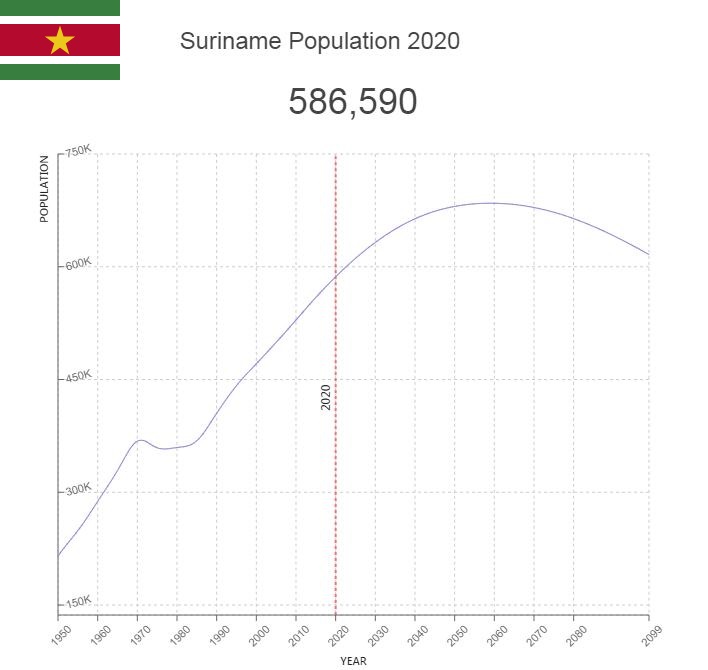Suriname Population

Suriname consists almost exclusively of dense, pristine rainforest. Political unrest, weak economy, military coup and civil war have characterized the country since independence in 1975.
Key figures and facts
- Capital: Paramaribo
- Ethnic groups: Hindustani (also known as “East Indians”) 27.4%, Maroons (descendants of escaped slaves) 21.7%, Creole (European-African mix) 15.1%, Javanese 13.7%, mixed 13.4 %, other 7.6%, unspecified 0.6% (2012)
- Language: Dutch (official), English (widely used), sranan togo (also called Surinamese or Taki-taki), Caribbean Hindustani (a Hindi dialect) and Javanese
- Religion: Protestants 23.6%, Hindus 22.3%, Catholics 21.6%, Muslims 13.8%, other Christians 3.2%, winti 1.8%, Jehovah’s Witnesses 1.2%, other/none/unspecified 12, 4%, (2012)
- Population: 568 301 (2018)
- Control Form: Constitutional democracy
- Area: 163 820 km2
- Currency: Surinamese dollar
- GNP per capita: 14 967 PPP $
- National Day: November 25th
Population of Suriname
In 2013, the population was estimated at 539,000 (World Bank). In the 1960s and 1970s, Suriname experienced a strong wave of emigration, mainly to the Netherlands. Despite natural growth in the population of more than 2%, emigration led to a decline in the population. Since the 1980s, emigration has slowed down due to restrictive immigration policy in the Netherlands, and there has been new growth. Annual population growth is estimated at 0.8% (2000-2005). Life expectancy for women is 74.1 years and for men 67.7 years.
The population is composed of many ethnic groups. The dominant group of people is Creole, a mix of Europeans, Asians and Blacks. These make up approximately 30% of the population. Otherwise, many Asians, especially Indians, Pakistanis and Indonesians, make up a total of 52% of the population. Blacks make up 10% of the population. The indigenous population consists of arawak (carib) speaking people groups, which together make up approximately 2%.
The average population density is 3.5 per km², but apart from the coastal zone with the capital Paramaribo, the country is very sparsely populated. Large areas in the south are completely or partially uninhabited.
Population of Suriname by Year (Historical)
| Year | Population | Annual Growth Rate | Population Density | Global Rank |
| 2020 | 586,521 | 0.910% | 3.7605 | 171 |
| 2019 | 581,261 | 0.930% | 3.7267 | 171 |
| 2018 | 575,879 | 0.960% | 3.6922 | 170 |
| 2017 | 570,385 | 0.990% | 3.6570 | 170 |
| 2016 | 564,777 | 1.030% | 3.6211 | 170 |
| 2015 | 559,032 | 1.110% | 3.5842 | 170 |
| 2010 | 529,020 | 1.160% | 3.3919 | 168 |
| 2005 | 499,353 | 1.180% | 3.2017 | 167 |
| 2000 | 470,838 | 1.280% | 3.0189 | 167 |
| 1995 | 441,740 | 1.750% | 2.8324 | 167 |
| 1990 | 405,057 | 1.910% | 2.5972 | 167 |
| 1985 | 368,527 | 0.500% | 2.3631 | 165 |
| 1980 | 359,408 | 0.020% | 2.3046 | 164 |
| 1975 | 359,115 | -0.480% | 2.3027 | 161 |
| 1970 | 367,820 | 2.270% | 2.3585 | 160 |
| 1965 | 328,825 | 2.700% | 2.1086 | 161 |
| 1960 | 287,760 | 2.940% | 1.8453 | 161 |
| 1955 | 248,889 | 2.980% | 1.5961 | 161 |
| 1950 | 214,891 | 0.000% | 1.3782 | 163 |
Major Cities in Suriname by Population
| Rank | City | Population |
| 1 | Paramaribo | 223,646 |
| 2 | Lelydorp | 18,112 |
| 3 | Brokopondo | 14,551 |
| 4 | Nieuw Nickerie | 13,032 |
| 5 | Moengo | 6,963 |
| 6 | Nieuw Amsterdam | 4,824 |
| 7 | Albina | 3,874 |
| 8 | Groningen | 3,105 |
| 9 | Onverwacht | 1,994 |
| 10 | Totness | 1,574 |
Religion
Almost all major world religions are represented, primarily Hinduism (27.4%), Christianity (48%), Islam (19.6%) and traditional religions (5%). There is a small group of Jews.
Language
Dutch is the official language. English and Hindi are also widely used. The pidgin language sranan (sranantonga) based in English, Dutch and African languages is used in the communication between the various peoples.













































